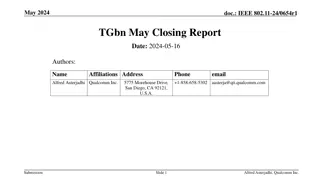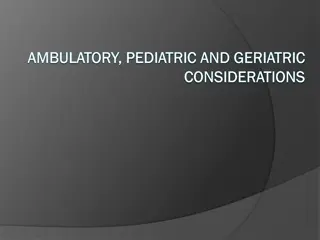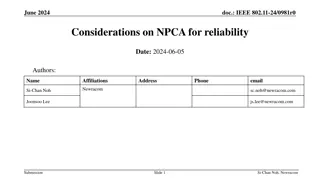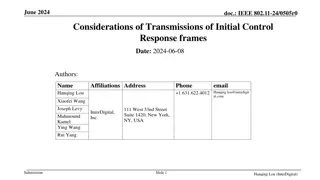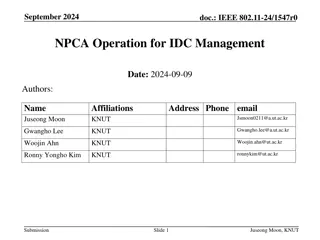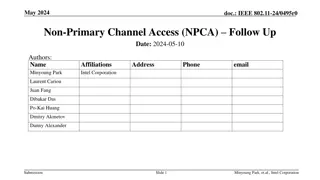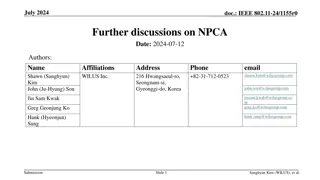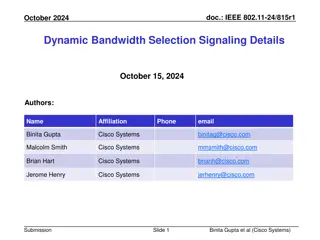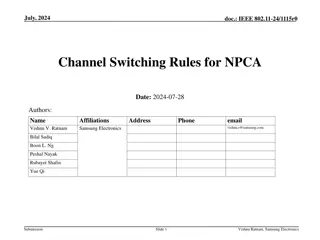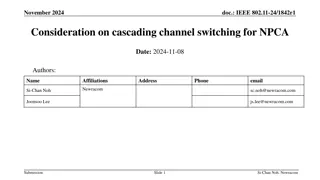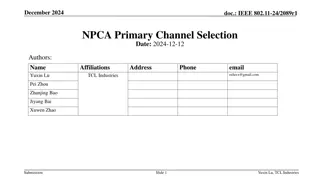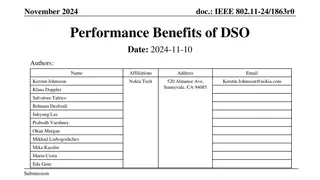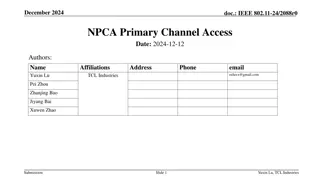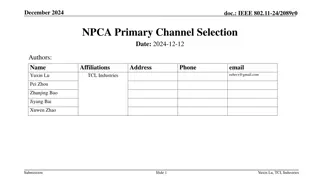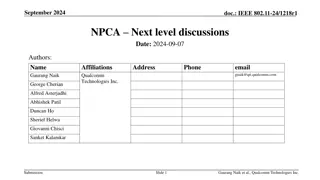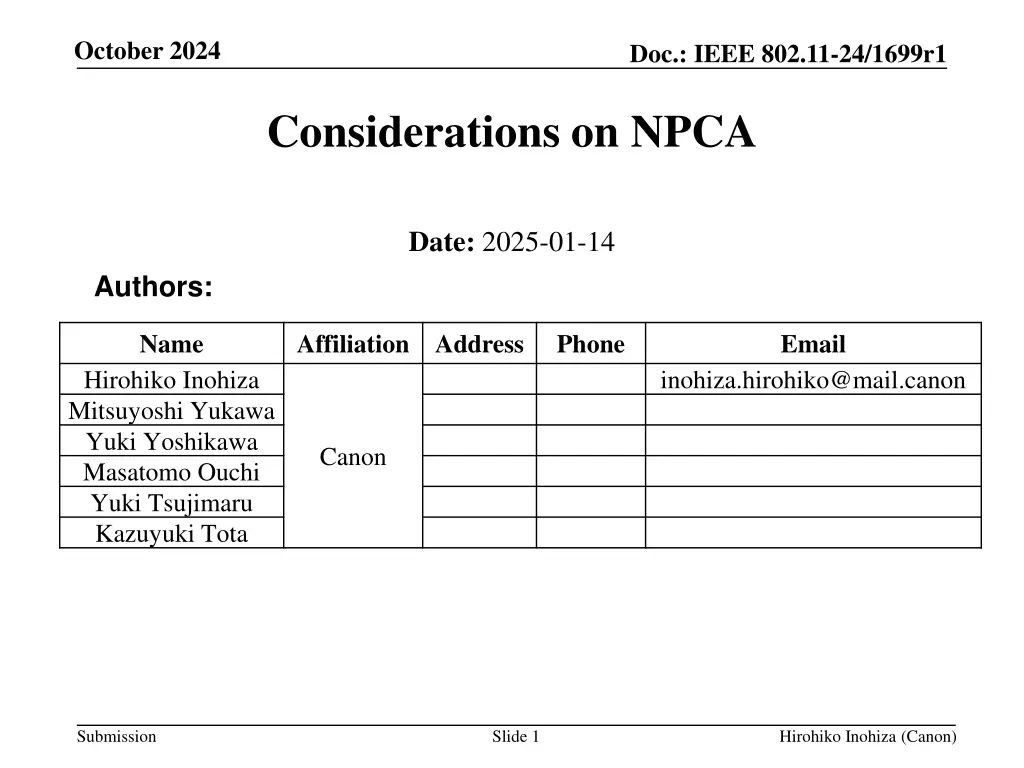
IEEE 802.11-24/1699r1: NPCA Considerations for Wi-Fi Efficiency
"Explore considerations for Non-Primary Channel Access (NPCA) in IEEE 802.11-24/1699r1, focusing on setting conditions, mode considerations, and constraints to enhance Wi-Fi efficiency and reduce congestion due to OBSS traffic."
Download Presentation

Please find below an Image/Link to download the presentation.
The content on the website is provided AS IS for your information and personal use only. It may not be sold, licensed, or shared on other websites without obtaining consent from the author. If you encounter any issues during the download, it is possible that the publisher has removed the file from their server.
You are allowed to download the files provided on this website for personal or commercial use, subject to the condition that they are used lawfully. All files are the property of their respective owners.
The content on the website is provided AS IS for your information and personal use only. It may not be sold, licensed, or shared on other websites without obtaining consent from the author.
E N D
Presentation Transcript
October 2024 Doc.: IEEE 802.11-24/1699r1 Considerations on NPCA Date: 2025-01-14 Authors: Name Affiliation Address Phone Email Hirohiko Inohiza Mitsuyoshi Yukawa Yuki Yoshikawa Masatomo Ouchi Yuki Tsujimaru Kazuyuki Tota inohiza.hirohiko@mail.canon Canon Submission Slide 1 Hirohiko Inohiza (Canon)
October 2024 Doc.: IEEE 802.11-24/1699r1 Introduction TGbn has agreed to define Non Primary Channel Access (NPCA) operation to enable a STA to access the nonprimary channel while the primary channel is known to be busy due to OBSS traffic. This contribution discusses consideration for the following aspects of NPCA. NPCA capability setting conditions NPCA mode setting conditions Constraints in NPCA Submission Slide 2 Hirohiko Inohiza (Canon)
October 2024 Doc.: IEEE 802.11-24/1699r1 NPCA capability setting conditions There are several contributions proposing capability of NPCA operation indicating whether NPCA operation is supported or not supported. (E.g.[1]) It is necessary to set NPCA capability properly according to particular conditions. Proposal: Define conditions for STAs to set NPCA capability. NPCA capability shall be set to not supported in a STA when, The operating band of an AP is 2.4GHz band. (since 2.4GHz band is always congested) NPCA capability may be set to supported in a STA when, The operating band of an AP is 5GHz or 6GHz band. NPCA capability may be indicated in Beacon frame, Probe Request/Response frame, or (Re)Association Request/Response frame. Submission Slide 3 Hirohiko Inohiza (Canon)
October 2024 Doc.: IEEE 802.11-24/1699r1 NPCA mode setting conditions There are several contributions proposing NPCA mode indicating whether NPCA operation is enabled or disabled. (E.g.[2]) NPCA mode should be set properly according to particular conditions. Assumption: NPCA capable STA operating in 20MHz cannot switch outside of its operating channel width Proposal: Define conditions for STAs to dynamically enable/disable NPCA mode. NPCA mode shall be disabled in a STA when, The operating channel width of a non-AP STA or AP is changed from channel width more than TBD MHz to equal or less than TBD MHz. NPCA mode may be disabled in a STA when, Any other conditions depending on implementation. (e.g. power saving, congestion status of NPCA primary channel, QoS requirement) NPCA mode may be enabled in a STA when, The operating channel width of a non-AP STA or AP is changed from equal or less than TBD MHz to channel width more than TBD MHz. Any other conditions depending on implementation. (e.g. power saving, congestion status of NPCA primary channel, QoS requirement) NPCA mode may be indicated in Action frames or MAC header. Submission Slide 4 Hirohiko Inohiza (Canon)
October 2024 Doc.: IEEE 802.11-24/1699r1 Constraints in NPCA NPCA should be performed only when the primary channel (PCH) s NAV is set due to OBSS traffic. Before NAV duration elapse, a STA switches back to PCH According to the rule above, a communication in NPCA primary channel with a STA not intending to operate in NPCA mode may lead to a situation degrading the communication efficiency. A non-associated STA transmitting a Probe Request frame and receiving Probe Response frame from an AP in NPCA primary channel may start authentication and association process in NPCA primary channel. In such case, after the AP switches back to PCH, the Non-AP STA cannot find the AP and cannot continue authentication and association process in NPCA primary channel. Proposal: To prevent the situation above, transmission of frames in NPCA primary channel shall be restricted. For example: Prohibit transmission of Beacon, Probe Response, Authentication, (Re)Association Response, etc. An NPCA AP shall only respond to a frame in the NPCA primary channel received from a NPCA STA that is associated to the NPCA AP. An NPCA STA shall only respond to a frame in the NPCA primary channel received from another NPCA STA which is the destination of ICF or the source of ICF. NAV (set by OBSS) AP PCH NPCH Probe Rsp PCH Non-AP STA (Non-associated) NPCH Auth(ReTx) Auth Probe Req Time Submission Slide 5 Hirohiko Inohiza (Canon)
October 2024 Doc.: IEEE 802.11-24/1699r1 Summary This contribution discusses consideration for the following aspects of NPCA NPCA capability setting conditions NPCA mode setting conditions Constraints in NPCA Submission Slide 6 Hirohiko Inohiza (Canon)
October 2024 Doc.: IEEE 802.11-24/1699r1 Reference [1] Secondary Channel Access and Frame Transmission, https://mentor.ieee.org/802.11/dcn/23/11-23-1911-00-00bn-secondary-channel- access-and-frame-transmission.pptx [2] Enabling Non-Primary Channel Access, https://mentor.ieee.org/802.11/dcn/24/11-24-0427-00-00bn-enabling-non-primary- channel-access.pptx [3] Secondary Channel Usage Follow Up, https://mentor.ieee.org/802.11/dcn/23/11-23-1935-01-00bn-secondary-channel- usage-follow-up.pptx Submission Slide 7 Hirohiko Inohiza (Canon)
October 2024 Doc.: IEEE 802.11-24/1699r1 SP1 Do you agree to include the following into the 11bn SFD? An NPCA STA may dynamically indicate a mode of NPCA indicating whether NPCA operation is enabled or disabled Detailed signaling is TBD Submission Slide 8 Hirohiko Inohiza (Canon)
October 2024 Doc.: IEEE 802.11-24/1699r1 SP2 Do you agree to include the following into the 11bn SFD? An AP shall indicate in the capability that the NPCA operation is not supported when the operating band of an AP is 2.4GHz band Submission Slide 9 Hirohiko Inohiza (Canon)
October 2024 Doc.: IEEE 802.11-24/1699r1 SP3 Do you agree to include the following into the 11bn SFD? An NPCA STA shall indicate in the NPCA mode that NPCA operation is disabled when the operating channel width of the NPCA STA is changed from channel width more than TBD MHz to equal or less than TBD MHz Submission Slide 10 Hirohiko Inohiza (Canon)
October 2024 Doc.: IEEE 802.11-24/1699r1 SP4 Do you agree to include the following into the 11bn SFD? An NPCA AP shall not transmit TBD frames when operating in the NPCA primary channel Submission Slide 11 Hirohiko Inohiza (Canon)
October 2024 Doc.: IEEE 802.11-24/1699r1 SP5 Do you agree to include the following into the 11bn SFD? An NPCA AP shall only respond to a frame in the NPCA primary channel received from a NPCA STA that is associated to the NPCA AP. Submission Slide 12 Hirohiko Inohiza (Canon)
October 2024 Doc.: IEEE 802.11-24/1699r1 SP6 Do you agree to include the following into the 11bn SFD? An NPCA STA shall only respond to a frame in the NPCA primary channel received from another NPCA STA which is the destination of ICF or the source of ICF. Submission Slide 13 Hirohiko Inohiza (Canon)

